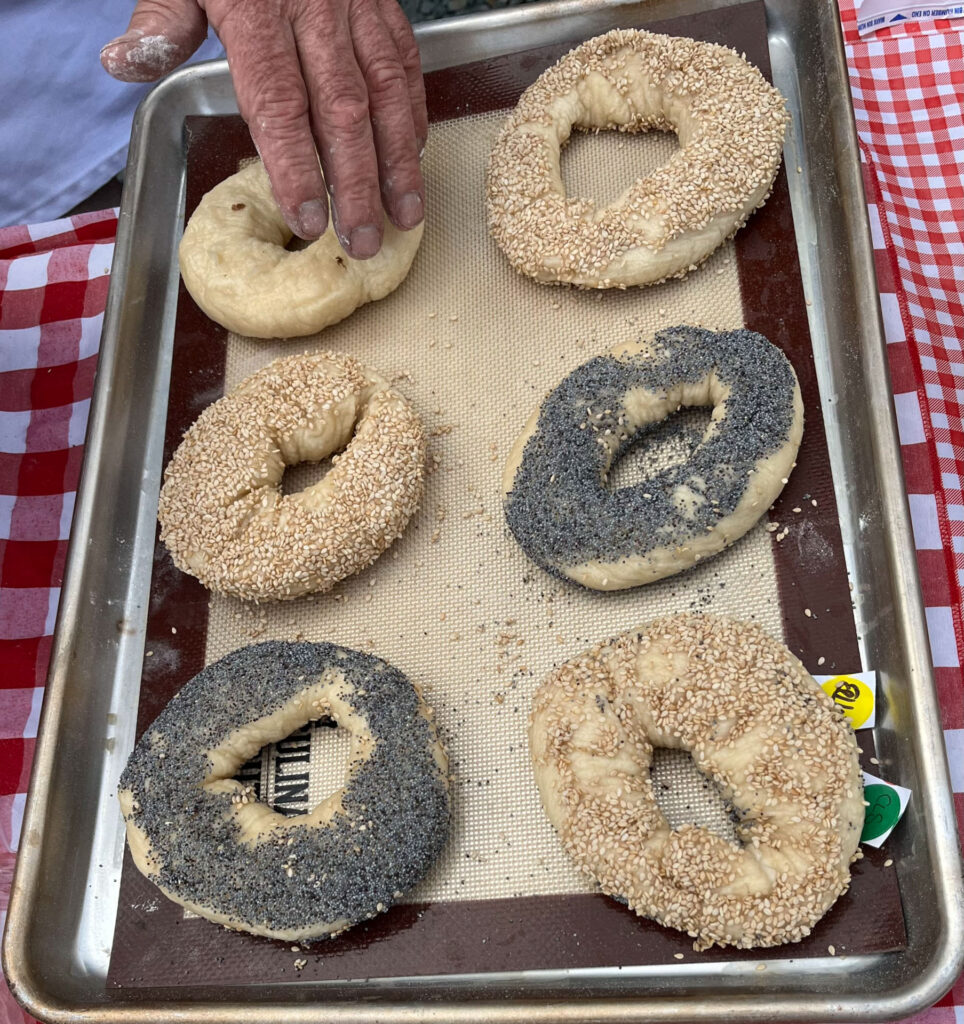By Curt Peterson
A dozen Hartlanders joined “master baker” Jeffrey Hamelman at the public pizza oven on Saturday morning, Sept. 7, bent on learning how to make bagels. Ten women, one rising 8-year-old girl, and an aging male journalist brought a short list of kitchen equipment.
One of the women, Sara Fuschetto, is a breadmaker at King Arthur Bakery in Norwich. Our professor quickly took advantage of her expertise and put her to work as his assistant.
“We have three goals today,” Hamelman began, “first, to learn something; second, to have fun; and third, to eat a bagel.”

Sherry Altman and her friend Ellie, 7, cut and then weigh dough to make 110-120 gram dough balls.
His plan was to teach the class in reverse — we would first make three bagels, then learn how the process works, taking some makings with us to bake bagels at home.
Students were spread out at a horseshoe-shaped table covered with classic red/white checked table cloths. Each participant laid out a cutting board, mixing bowl, plastic wrap, a beverage and a bag for carrying finished products home.
Hamelman floured his own cutting board and plopped a rectangular lump of dough on it. He began cutting pieces, placing them on a digital cooking scale.
“The ideal amount of bagel dough will be between 110 and 120 grams,” he said, adding and subtracting small lumps to achieve a perfect weight.
We each received our own lump of dough from which we cut three pieces, weighing them as we were shown. Then we manipulated the sized dough into three fat “fingers,” which we pressed in the center to form a “barbell” shape. After kneading into a tube shape, we connected the two ends, making a circular bagel shape.
Hamelman dropped his six bagels into a deep mixture of boiling water and 3% honey. After about a minute, he removed his six bagels and drained them.
“The honey provides a crusty texture and shiny appearance,” he explained. “And the less we boil the bagels, the chewier they will be.”

Six demo bagels made by Jeff Hamelman gave participants examples to strive toward.
Two aluminum pie plates contained poppyseeds, and sesame seeds. The still damp and slightly sticky bagels were dropped into the pie plate of choice, then turned over so the flavorful tidbits stuck to both sides.
“Proofing,” he explained, is making sure whatever you’re baking retains its shape until it goes into the oven.
Hamelman carefully placed his six bagels into the flaming brick and mortar oven, arranging the burning wood and checking frequently to make sure they didn’t overcook or burn. When we finished and “seeded” ours, they were placed six-to-a-tray, and he placed them in the oven two trays at a time.
While our attempts were baking, Hamelman shared historic tales of bagels and stories about his global baking and teaching experiences.
We sat at a picnic table and shared the baker’s six bagels with cream cheese or butter, while he recounted some of his experiences baking around the globe.
He grew up on Long Island. He had his own bakery in Brattleboro for a time, and has made multiple trips to Uganda to teach basic breadmaking, and created the baking and education center at King Arthur. He taught us how to make bagels with such joy, we asked if making them was his favorite baking pastime.
“I’ve baked many kinds of breads,” he said, “and pastries, cakes, tortes, chocolates and wedding cakes. I love them all.”
We each took our three bagels and an instruction sheet with us, along with dough to make more at home.



